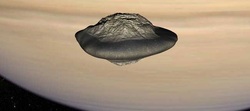Life on the Moons in the Solar System
Explore these interactive sites:
Saturn's moon Enceladus: http://saturn.jpl.nasa.gov/multimedia/flash/Enceladus/enceladus.html
Saturn's moon Titan: http://saturn.jpl.nasa.gov/multimedia/flash/Titan/index.html
Planet Trip Planner: http://planetquest.jpl.nasa.gov/gallery/planetZone_tripPlanner.html
3-D Guide to the Milky Way Galaxy: http://planetquest.jpl.nasa.gov/milky-way/milky_way.html
Saturn's moon Enceladus: http://saturn.jpl.nasa.gov/multimedia/flash/Enceladus/enceladus.html
Saturn's moon Titan: http://saturn.jpl.nasa.gov/multimedia/flash/Titan/index.html
Planet Trip Planner: http://planetquest.jpl.nasa.gov/gallery/planetZone_tripPlanner.html
3-D Guide to the Milky Way Galaxy: http://planetquest.jpl.nasa.gov/milky-way/milky_way.html
Earth's Moon
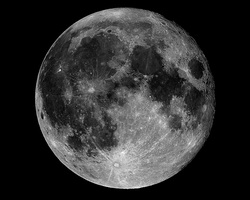
Earth's moon plays an important part in helping life to exist on Earth. It helps the ocean tides be balanced and creates biological rhythms on the planet. It is the 5th largest moon in the solar system.
Scientists believe the moon may have originally come from the Earth, but popped out after a Mars-sized object slammed into Earth. This debris formed itself into a sphere, becoming our moon.
The moon is the only other object in the solar system humans have actually visited. The first moon landing happened in July 1969.
The surface of the moon is heavily cratered. There are also large plains called marias.
Scientists have discovered water ice on the moon. Liquid water cannot exist on the moon because it burns off too quickly into space. There is no atmosphere on the moon.
Scientists believe the moon may have originally come from the Earth, but popped out after a Mars-sized object slammed into Earth. This debris formed itself into a sphere, becoming our moon.
The moon is the only other object in the solar system humans have actually visited. The first moon landing happened in July 1969.
The surface of the moon is heavily cratered. There are also large plains called marias.
Scientists have discovered water ice on the moon. Liquid water cannot exist on the moon because it burns off too quickly into space. There is no atmosphere on the moon.
Mars' Moons
Phobos
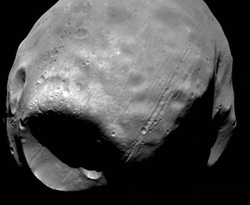
Phobos, named after one of the sons of the Greek War God Ares, is an irregular moon, which means it doesn't have enough mass to pull itself into a spherical shape.
Phobos has many craters, including the giant crater in the front. Because it is so small, it has no atmosphere and has trouble retaining heat. Temperatures can change from 25 degrees Fahrenheit during the day to -170 degrees Fahrenheit at night. There is no water on this rocky moon, only dirt.
One interesting thing about Phobos is it rotates Mars three times a day. It also gets closer to Mars every year and will one day crash into the planet.
Phobos has many craters, including the giant crater in the front. Because it is so small, it has no atmosphere and has trouble retaining heat. Temperatures can change from 25 degrees Fahrenheit during the day to -170 degrees Fahrenheit at night. There is no water on this rocky moon, only dirt.
One interesting thing about Phobos is it rotates Mars three times a day. It also gets closer to Mars every year and will one day crash into the planet.
Deimos
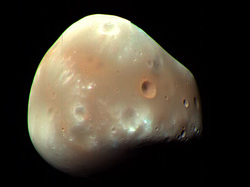
Deimos is the smaller of Mars' two moons. Deimos is also named after one of Ares' sons. It is also an irregular moon, more like a weird-shaped rock.
Deimos has many craters from being hit too much from asteroids. Deimos is also extremely cold because it doesn't have any atmosphere. It also has no water.
Deimos is moving farther away from Mars every year and will one day break free, which will leave Mars without any moons.
Deimos has many craters from being hit too much from asteroids. Deimos is also extremely cold because it doesn't have any atmosphere. It also has no water.
Deimos is moving farther away from Mars every year and will one day break free, which will leave Mars without any moons.
Jupiter's Moons (Jovian Satellites)
Io
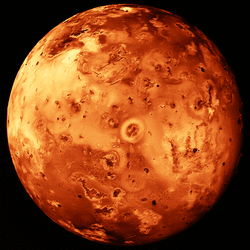
Io is the most volcanic planet on the planet. It is covered with volcanoes that erupt on a regular basis. Because of this, the surface of Io is always changing. Scientists have even seen eruptions go into space.
The gravity of Jupiter bends and stretches the moon, which makes most of the surface liquid lava.
There is a thin atmosphere on Io, made mostly of sulfur dioxide, which is toxic and impossible for living organisms to use. There is no liquid water on this moon.
When Io crosses through Jupiter's large magnetic field, it turns Io into a giant electrical conductor, which means Io can create a large amount of electricity. This electricity moves from Io to Jupiter, creating lightning on Jupiter.
The gravity of Jupiter bends and stretches the moon, which makes most of the surface liquid lava.
There is a thin atmosphere on Io, made mostly of sulfur dioxide, which is toxic and impossible for living organisms to use. There is no liquid water on this moon.
When Io crosses through Jupiter's large magnetic field, it turns Io into a giant electrical conductor, which means Io can create a large amount of electricity. This electricity moves from Io to Jupiter, creating lightning on Jupiter.
Callisto

Callisto is the 3rd largest moon in the solar system and is almost as large as Mercury. Callisto orbits far away from Jupiter.
Because of the materials that the surface of Callisto are made of, Callisto appears about twice as bright as our moon. Callisto has had more craters hit it than any other object in the solar system. Its surface has not changed in thousands of years, making it the oldest surface in the solar system as well.
Because of the materials that the surface of Callisto are made of, Callisto appears about twice as bright as our moon. Callisto has had more craters hit it than any other object in the solar system. Its surface has not changed in thousands of years, making it the oldest surface in the solar system as well.
Ganymede
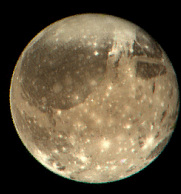
Ganymede is the largest moon in the solar system. It is larger than Mercury and Pluto and 3/4 the size of Mars. Ganymede is basically a giant ice moon. Its surface is mostly ice, which means there could possibly be liquid water underneath, but scientists are not sure on this.
Scientists were surprised to find that there was small amounts of oxygen in Ganymede's atmosphere, but there is not enough oxygen to support life.
Scientists were surprised to find that there was small amounts of oxygen in Ganymede's atmosphere, but there is not enough oxygen to support life.
Europa
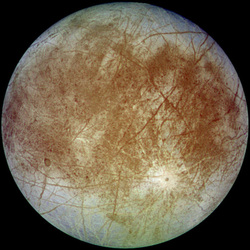
Europa is a more Earthlike object than all the other planets in the solar system. It is about the size of Earth's moon, but behaves more like Earth. It has an iron core, a rocky surface and a surface ocean of salt water. This ocean covers the ENTIRE planet. But, because the moon is so far from the Sun, the ocean is frozen over at the surface, but liquid underneath.
Europa orbits Jupiter every 3.5 days with the same side of the moon facing Jupiter at all times. Because of the way Europa orbits Jupiter, it causes the moon to heat up, making it warmer than it normally would be. This means there could possibly be ocean life living underneath the surface of Europa.
Europa orbits Jupiter every 3.5 days with the same side of the moon facing Jupiter at all times. Because of the way Europa orbits Jupiter, it causes the moon to heat up, making it warmer than it normally would be. This means there could possibly be ocean life living underneath the surface of Europa.
Saturn's Moons
Titan
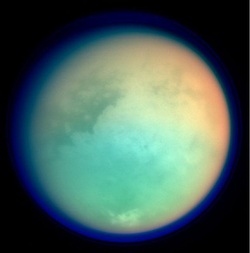
Titan is the largest of Saturn's moons and the second largest moon in the solar system. It is larger than Mercury. It is a freezing cold moon that is covered by a thick, fuzzy atmosphere that telescopes cannot see through. The atmosphere is thick enough to possibly support life and has clouds in the atmosphere. The atmosphere is made of mostly nitrogen but it also has high amounts of methane and ethane, which are toxic to most life. When it rains on Titan, the rain would be more like gasoline than like water.
Because it is so difficult for our satellites to see through Titan's atmosphere, we aren't really sure what the surface is like. It seems like there is at least one continent, but scientists don't know if that means there are oceans or not.
Because it is so difficult for our satellites to see through Titan's atmosphere, we aren't really sure what the surface is like. It seems like there is at least one continent, but scientists don't know if that means there are oceans or not.
Iapetus
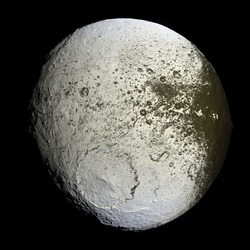
This planet is half dark and half light. Scientists aren't really sure why one side is darker than another or what's causing the darkening, though it may be from ice volcanoes.
Iapetus orbits Saturn every 79 days. Because its days are so long, it can absorb more sunlight and warm up more. Even with how much it warms up, it is still too cold and icy for life. In fact, Iapetus is so icy that 3/4 of the planet is ice and only 1/4 is rock.
Iapetus is also known for a stretch of mountains, some of which are 6 miles high.
Iapetus orbits Saturn every 79 days. Because its days are so long, it can absorb more sunlight and warm up more. Even with how much it warms up, it is still too cold and icy for life. In fact, Iapetus is so icy that 3/4 of the planet is ice and only 1/4 is rock.
Iapetus is also known for a stretch of mountains, some of which are 6 miles high.
Phoebe
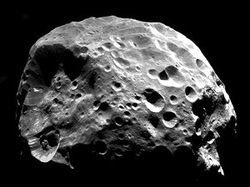
Phoebe orbits very far from Saturn. It is about 1/15 the diameter of Earths' moon and rotates on its axis every nine hours. However, because it is so far from Saturn, it takes a year and a half to orbit the planet. Phoebe's orbit is retrograde, which means it orbits backwards around the planet from the other moons.
Phoebe does not reflect very much light, so it is a darker moon. Scientists think Phoebe was originally not from near Saturn, but it got too close and Saturn pulled it in and made it one of its moons. There is no atmosphere or water because it is not large enough to support a stable atmosphere.
Phoebe does not reflect very much light, so it is a darker moon. Scientists think Phoebe was originally not from near Saturn, but it got too close and Saturn pulled it in and made it one of its moons. There is no atmosphere or water because it is not large enough to support a stable atmosphere.
Mimas
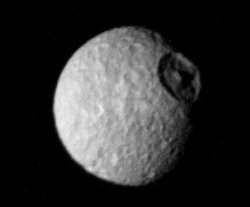
Mimas is covered in craters and is the smallest of Saturn's moons. It is also the closest moon to Saturn. It is most famous for its one large crater, named Herschel, after the person who discovered the moon. Herschel is 130km across and has a central mountain peak that is 6km high. This crater suggests that the asteroid that hit was a very large asteroid and could have almost broken the moon apart.
Mimas orbits Saturn in only 23 hours. It appears that the entire surface of Mimas is water ice. However, it is so far away that it is frozen solid.
Mimas orbits Saturn in only 23 hours. It appears that the entire surface of Mimas is water ice. However, it is so far away that it is frozen solid.
Enceladus
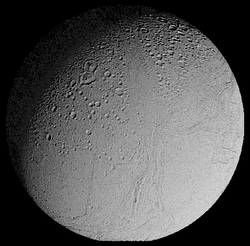
Enceladus is near to Saturn and about the same size as Mimas, but it has a much smoother and brighter surface. It reflects almost all the sunlight it receives, making it very bright. It does have many craters, but most of these are small.
Scientists believe that the smooth areas of the moon indicate that the interior of the moon may be liquid. Because of the way Enceladus orbits around Saturn, it causes the moon to be heated from inside. However, that heat doesn't do enough because the moon is still -330 degree Fahrenheit.
Enceladus does have a thin atmosphere that comes from gases inside the moon. There appears to be some water vapor in the atmosphere. The gases that come from the interior of Enceladus erupt like water fountains and help make one of Saturn's rings, the E-Ring.
Scientists believe that the smooth areas of the moon indicate that the interior of the moon may be liquid. Because of the way Enceladus orbits around Saturn, it causes the moon to be heated from inside. However, that heat doesn't do enough because the moon is still -330 degree Fahrenheit.
Enceladus does have a thin atmosphere that comes from gases inside the moon. There appears to be some water vapor in the atmosphere. The gases that come from the interior of Enceladus erupt like water fountains and help make one of Saturn's rings, the E-Ring.
Hyperion
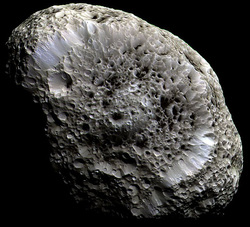
Hyperion is one of the strangest moon surfaces in the solar system. It is a very irregular shape and has a surface that looks kind of like a sponge. Hyperion has a strange orbit around Saturn and its orbit changes each time it goes around Saturn. Hyperion is slightly reddish, but it also has dark elements. Hyperion may have crashed with another large object, which broke it apart into its strange shape.
It does not have any water or atmosphere. It is too unstable of a moon for life to exist upon.
It does not have any water or atmosphere. It is too unstable of a moon for life to exist upon.
Tethys
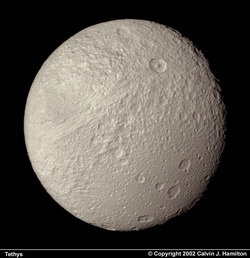
This moon is made almost completely of water ice. This moon has been hit by many asteroids and has many cracks in the surface, which means there may be a more liquid water underneath causing the cracks to appear.
Tethys has a giant trench that is 40 miles wide and several kilometers deep. This trench covers 3/4 of the moon's surface. Tethys is a freezing ice world, with temperatures around -305 degrees Fahrenheit.
Tethys has a giant trench that is 40 miles wide and several kilometers deep. This trench covers 3/4 of the moon's surface. Tethys is a freezing ice world, with temperatures around -305 degrees Fahrenheit.
Uranus' Moons
Unlike the moons of Jupiter and Saturn, the moons of Uranus are named after characters from the plays of famous author/playwright/poet William Shakespeare.
Oberon
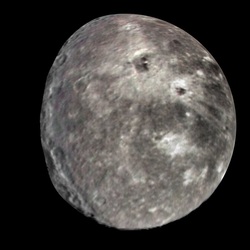
Oberon is the outer moon around Uranus and is the second largest moon around Uranus and 9th largest in the solar system. Oberon orbits Uranus once every 13.5 days and the same side of the moon always faces the planet. Oberon is tilted on its side, like Uranus, and has super long seasons. One season can last 42 years, which mean some parts of the planet are fully lit for 42 straight years and some are dark for 42 straight years.
The moon appears to have a rocky core and a mantle made of ice. Scientists think there may be liquid water deep down between the core and the mantle, but that would be too deep for life to exist. The moon has a slightly red color and is covered with many asteroid impacts.
This cold moon has no atmosphere and could not support life.
The moon appears to have a rocky core and a mantle made of ice. Scientists think there may be liquid water deep down between the core and the mantle, but that would be too deep for life to exist. The moon has a slightly red color and is covered with many asteroid impacts.
This cold moon has no atmosphere and could not support life.
Titania

Titania is the largest moon that orbits Uranus. Its surface is covered with fault lines, which seems to indicate there is geological activity happening beneath the surface, much like Earth.
Titania's surface is composed of equal parts rock and ice. Water ice and carbon dioxide are present on the surface of Titania and it seems to have a small atmosphere of carbon dioxide, though it is not very strong. So, while there is plenty of water ice and an atmosphere, it is far too cold on Titania for life to exist.
Titania's surface is composed of equal parts rock and ice. Water ice and carbon dioxide are present on the surface of Titania and it seems to have a small atmosphere of carbon dioxide, though it is not very strong. So, while there is plenty of water ice and an atmosphere, it is far too cold on Titania for life to exist.
Umbriel
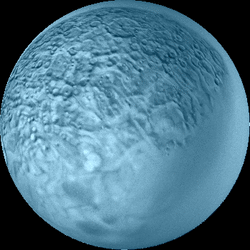
Umbriel is the darkest of Uranus' moons. It has a heavily cratered surface. The surface of the moon is made mostly of water ice and rock. There also seems to be some carbon dioxide on the surface of the moon.
The surface of the planet is slightly blue, which is different from Oberon and Titania, which appear slightly red. There does not seem to be any atmosphere on this moon and it is a freezing cold rock.
The surface of the planet is slightly blue, which is different from Oberon and Titania, which appear slightly red. There does not seem to be any atmosphere on this moon and it is a freezing cold rock.
Miranda
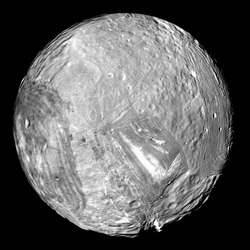
Miranda is one of the strangest moons in the solar system. It is much smaller than our moon, but doesn't seem like any other moon. It kind of looks like a bunch of strange pieces were squished together into a moon.
The most unique feature on Miranda are three race-track shaped areas called coronae. These have deep canyons which are 12 times deeper than Earth's Grand Canyon.
Like the other moons of Uranus, Miranda is made of equal parts water ice and rock. Because the moon is so small, it could not support an atmosphere.
The most unique feature on Miranda are three race-track shaped areas called coronae. These have deep canyons which are 12 times deeper than Earth's Grand Canyon.
Like the other moons of Uranus, Miranda is made of equal parts water ice and rock. Because the moon is so small, it could not support an atmosphere.
Neptune's Moons
Neptune's moons are named after various sea myths.
Nereid
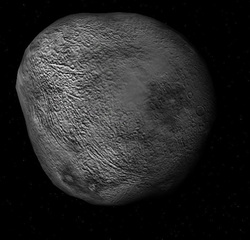
Nereid rotates far away from Neptune and takes 360 days to make one complete orbit. With its weird shape, it is believed Nereid was a captured asteroid or some other object that came from the areas around Pluto.
The surface of Nereid is water ice. The surface temperature is around -370 degrees Fahrenheit. It is to small and irregular shaped to have an atmosphere.
The surface of Nereid is water ice. The surface temperature is around -370 degrees Fahrenheit. It is to small and irregular shaped to have an atmosphere.
Triton
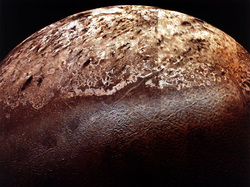
Triton is Neptune's largest moon and orbits in the opposite direction of the planet and all the other moons around Neptune. This moon is strange, seeming more like a dwarf planet than like a normal moon. In fact, scientists compare this moon to Pluto because they are quite similar. Scientists believe Triton was an object that came from the same area as Pluto, but came to close to Neptune and Neptune pulled it in as one of its moons.
There is a lot of volcanic activity on this moon, but the lava is ice lava. The crust of Triton is nitrogen and the core is some type of metal.
Because of its size and volcanic activity, Triton has a thin atmosphere of carbon and methane. However, this is one of the coldest moons in the solar system. The nitrogen from the lava flows turns into frost quickly, which makes the planet appear very frozen. This also reflects a lot of light. The temperature on Triton is -391 degrees Fahrenheit.
There is a lot of volcanic activity on this moon, but the lava is ice lava. The crust of Triton is nitrogen and the core is some type of metal.
Because of its size and volcanic activity, Triton has a thin atmosphere of carbon and methane. However, this is one of the coldest moons in the solar system. The nitrogen from the lava flows turns into frost quickly, which makes the planet appear very frozen. This also reflects a lot of light. The temperature on Triton is -391 degrees Fahrenheit.
Proteus
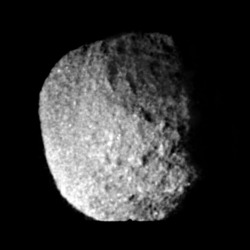
Proteus is the second-largest moon around Neptune. It is an irregular-shaped moon that is filled with craters. It is a dark moon and does not reflect much light. Scientists are not sure what the surface of the moon is made of, but believe it is probably water ice, like the other moons of Uranus and Neptune.
Scientists believe Proteus is about as big as a moon can be before being fully pulled into a spherical shape. Because it is not big enough to be a sphere, it does not have enough gravity to have an atmosphere.
Scientists believe Proteus is about as big as a moon can be before being fully pulled into a spherical shape. Because it is not big enough to be a sphere, it does not have enough gravity to have an atmosphere.
